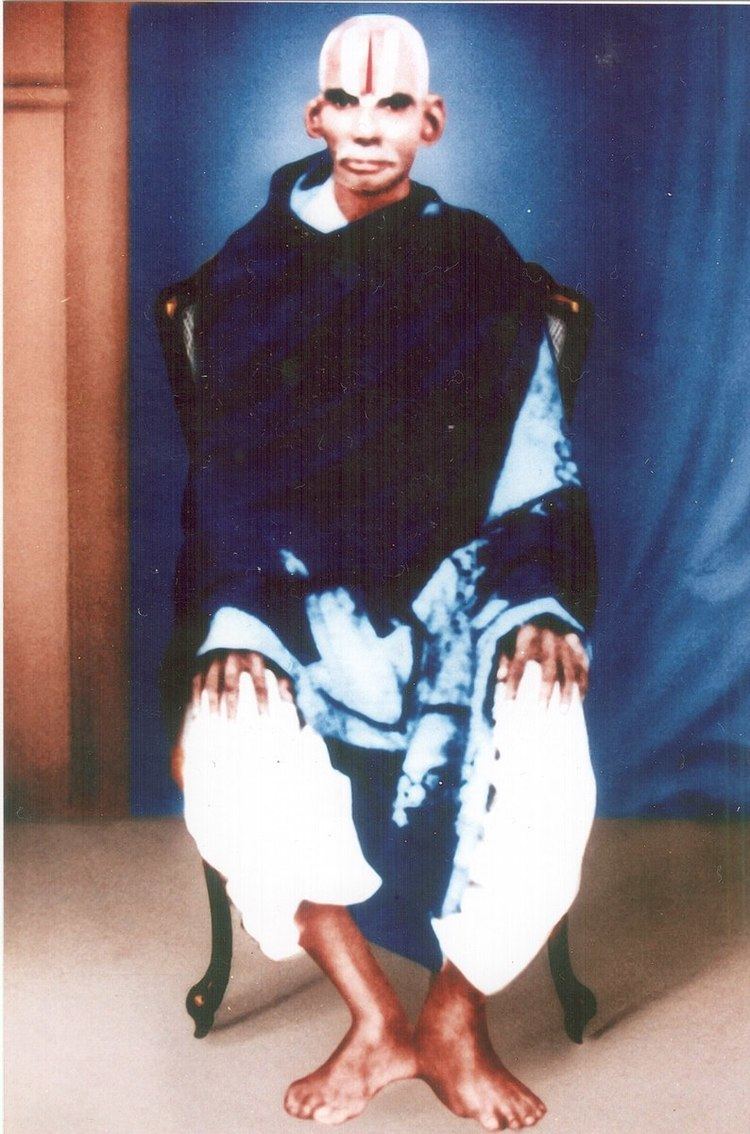Name Thiru Iyengar | Died July 29, 1947 | |
 | ||
Born 31 October 1861 EthirkOtai, India | ||
Maha vidhwan Thirumaaligai Appan Narayana Iyengar was born to Thirumaaligai Appan Iyengar and Shenkamalavalli Ammal on 31 Oct 1861 in EthirkOtai near Srivilliputhur. After having learnt the basics of Tamil literature and grammar from his father Appan Iyengar and other scholars near his home town during his formative years, he moved to Ramanathapuram.
Contents

Initial years and education
Iyengar learnt Sankrit literature and grammar from Pandalkudi Venkatachariar, tarka sastra from Samaacharyar and Vaishnava literature including Naalayira Divya Prabhandham from Sidhadikkaadu Srinivasachariar. He also learnt the Shaiva literature like Sivagyana bodham, Sivagyaana Sidhiyaar, Thevaaram, Tiruvasakam from Palanikumara Thambiraan of Thiruvaavaduthurai Aadheenam.
He, along with Paandithurai Thevar, zamindar of Paalavanatham did their residential education with Sadavadhaanam Muthuswamy Iyengar, father of Mu Raghava Iyengar. During his education, his versatility in both Sanskrit and Tamil literature, his knowledge of Astrology, medicine and tarka sastra impressed Paandithurai Thevar so much that he made him his official poet.
Literary work
Iyengar translated the Sanskrit literature "Jaathakachandrika", a text on horoscope study in to Tamil (venpa yaappu) quartet poems on the request of the zamindar. This work was published and released by the zamindar in his court.
Iyengar also helped Paandithurai Thevar in publishing the Panoorthirattu.
When Paandithurai Thevar established the Madurai Tamil Sangam on 24 May 1901, he assigned Iyengar management responsibilities in the Sangam for which he moved to Madurai.
Iyengar was in the management team of the Madurai Tamil Sangam since its inception. He was the first head of the Senthamil College institution and performed it for 45 years. Apart from that he also performed other functions – administrator, editor of Senthamizh magazine. Thiru Narayana Iyengar was the editor of the Senthamizh monthly from 1911. until his passing away in 1947.
It was during this period as Senthamizh editor that he did many research works in Tamil and Sanskrit literature and published his works in the monthly journal. His articles in the Senthamizh magazine on literature - Tamil and Sanskrit, grammar, tarka sastra, history and religion were informative to the readers. His expertise in these topics, his unbiased position in assessing the different points of view, his fearlessness to state the facts were well commended by the readers of Senthamizh. He published many such works in the magazine and which were later published as books.
In 1938, Iyengar wrote a paper titled Valmiki and Tamil in Senthamizh monthly, which analysed Maharishi Valmiki’s relationship with Tamil and whether Tamil could have been the spoken language throughout India during the Ramayana times.
His work Bharathazhwan Vaibhavam in the Senthamizh magazine was discussed in the Tamil literary circles. In that work, the detailed meaning given by Thiru Narayana Iyengar for the Kamban song that begins "Vanthethire thozhuthaanai" were refuted by Naavalar Somasundara Bharathiar. Thiru Narayana Iyengar’s reply to that rebuttal with detailed grammatical explanations and poetic nuances are even today a feast for the lovers of the Tamil language. He published both Naavalar’s objections and his explanations in the Senthamizh magazine.
He was in the education advisory committee of the Madras University, Annamalai University and the Yaazhpaana Arya Dravida Bhasha Abiviruthi Sangam. He was dedicated to Madurai Tamil Sangam and loyal to Paandithurai Thevar that he did not take up opportunities that came to him from other universities.
During the 80th birthday celebrations of Ue. Ve. Swaminatha Iyer, Iyengar requested him to write his autobiography and that encouraged Ue. Ve. Swaminatha Iyer to write "என் சரித்திரம்". When Ue. Ve. Swaminatha Iyer retired from Annamalai University, Annamalai Chettiar requested Thiru Narayana Iyengar to join the university. Although more remunerative and in spite of Ue. Ve. Swaminatha Iyer requesting him, Thiru Narayana Iyengar turned it down since he derived very high satisfaction from his work at the Madurai Tamil Sangam. In his reply to Thiru Narayana Iyengar, Swaminatha Iyer quoted Thiruvalluvar’s kural - "வேண்டாமை அன்ன விழுச்செல்வம்" and said that he was the one with the greatest asset – needlessness.
Here below are what some of the various Tamil literati had to say about him:
Naavalar Somasundara Bharathiar said of him – "நிரம்பிய இருமொழிக் கல்வியும் வரம்பளந்த அளவை நூலறிவும், நுண்மதியும், நடுவுநிலை திறம்பாத உளச் செம்மையும், சாந்த சீலமும் வாய்ந்த பெரியார் - a respectable elder with complete dual language knowledge, boundless knowledge of the books, refined sharp intelligence, unwavering judiciousness and equanimous".
"இருமொழிப் பயிற்சியிலும், இலக்கணம் தர்க்கம் ஆகிய துறைகளிலும் அவரைப் போன்ற வித்வான்களைப் பார்க்க முடியாது - It is difficult to see an expert as good as him in dual language knowledge, grammar and logical reasoning" said the head of the department of Tamil in Madras University, Rao Sahib Thiru S. Vaiyapuri Pillai.
"ஆசிரியர் செந்தமிழ் இதழில் வெளியிட்ட பொருளுரைகள் தமிழ்மொழி வளர்ச்சிக்கு இன்றியமையாதன - Senthamizh editor’s essays with detailed meanings were an important contribution for the growth of the Tamil language" so said Sunnaakam A Kumaarasaami Pulavar.
Mu Raghava Iyengar of the Madurai Tamil Sangam had said "நூற்றுக் கணக்கான மாணவர்களுக்கு தமிழறிவூட்டி அக்கல்வித் துறையைப் பரவச் செய்து தமிழக குலபதியாக விளங்கியவர் - Thiru Narayana Iyengar instilled the knowledge of Tamil literature to hundreds of students, was responsible for the growth of Tamil literature and can be called the leader".
Recognition
1896 – During Queen Victoria Jubilee celebrations he won accolades for his contributions to Tamil from the Deputy-Collector Rajaramaiyya
1922 Jan 13 Madras government awarded him a golden armlet, gold medal and shawl from the Prince of Wales for his literary eminence in Tamil
1934 for the 33rd anniversary of Madurai Tamil Sangam, awarded the cash prize and shawl for his contributions to Tamil Sangam by the Governor of Chennai Muhamad Usman Sahib Bahadur
1945 - Ruler of Sethu Shanmuga Raajeswara Naaganaatha Sethupathi awarded the Gold medal and silk shawl
Papers and books
Listed below are some of the papers and books written by Thiru Narayana Iyengar. Apart from this he has submitted over 50 papers on grammar, literature, tarka sastra, astrology, history and religion
